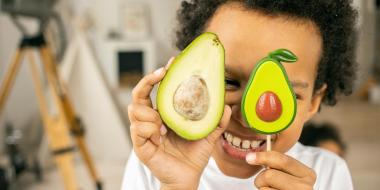Summer is within reach! I’m hoping you are all enjoying the outdoors and staying active. In my family, summer is filled with swimming, running, biking, and so much more. With all this fun, it is easy to forget about healthy nutrition. Did you know: the combo of warm weather and increased activity means more attention is needed on food and fluid intake? Read on for my two cents!
Fueling the body
Good nutrition for an active lifestyle means thinking about WHAT you eat, and WHEN. A focus on FLUID intake is also crucial. In general, overall food consumption should go up with activity levels.
A quick physiology lesson: the body can use dietary carbohydrates, protein, and fat for fuel. Carbohydrates are broken down into glucose, which circulates in the blood, or gets stored as glycogen. Glycogen is found in the liver, muscle, and brain. During exercise, it is broken back down into glucose for fast energy. It is the body's preferred form of energy as it is readily accessible. Protein cannot be stored well in the body, so when eaten it is broken down into amino acids. These are used in various ways like making enzymes, hormones, and forming building blocks of bones, muscles, and blood. Fat can be broken down for fuel as fatty acids, or stored in the body as triglycerides.
How does exercise burn fuel?
There are many factors determining what fuel muscles will use during exercise. These include exercise intensity, duration, a person’s fitness level, dietary intake, age, and gender. This is a complex science. For instance, low intensity movement (i.e. walking) is fueled more by fat. Moderate intensity sports (i.e. jogging or cycling) rely on a mix of carbohydrates (muscle glycogen breakdown and circulating blood sugar) and fat (fatty acids). As intensity increases (and duration stays limited) carbohydrates (glycogen breakdown) become a bigger fuel source. We see this in sports requiring intermittent bursts of high intensity sprints like basketball and soccer.
In terms of duration, the longer an activity lasts, the greater contribution fat has as the fuel. Protein can be used in late stages of prolonged exercise when glycogen stores have already fallen. Protein is also key for resistance exercise (like weights), and for recovery to rebuild and repair damaged muscle.
Eating to optimize exercise
In general, a meal should be eaten 1- 4 hours before exercise. This meal should contain a combination of high quality protein, healthy fat and unrefined carbohydrates. If eating on the shorter end of that range, aim for a small meal that is easy to digest. Eating during exercise is sometimes recommended (i.e. if it lasts over 2 hours). This snack should contain mainly carbohydrates and possibly some protein. Finally, it is always important to eat once you finish exercise (ideally within the first hour). Here carbohydrates and protein are best. Drinking is recommended before, during, and after a workout.
The hydration obligation
Your body produces sweat in order to cool down during exercise. If activity is combined with warmer temperatures (and increased humidity) you are at higher risk for dehydration. Be sure to sip on water throughout exercise! A rule of thumb is to drink half your weight (in pounds) in fluid ounces/day, plus 8 additional fluid ounces for every half hour of exercise.
If your exercise was particularly strenuous (or it’s very hot) consider an oral rehydration solution to balance your depleted electrolytes. If you are going to be active again in the next 8 hours, then electrolyte balancing is again a good idea. There are plenty of commercially available options but a simple homemade recipe contains 1 litre of water with 6 teaspoons of sugar, and ½ teaspoon of salt. Try this recipe for a delicious make-your-own electrolyte drink without chemical additives or tons of sugar.
Ideas for pre-workout meals
- Organic free range scrambled eggs on whole grain toast with grass-fed butter
- Gluten free oatmeal topped with chia seeds, hemp hearts, and blueberries
- Dr. Heidi’s Malted Maca Smoothie
Ideas for during-workout snacks
- Fruit
- Protein bar
- Dr. Heidi’s Get Your Greens Smoothie
Ideas for post-workout meals
- Grilled chicken and broccoli
- Grain salad with brown rice, veggies, and non-GMO tofu
- Dr. Heidi’s Strawberry Protein Smoothie

What about vegetarian or vegan athletes?
Training increases your demand for iron, protein, calcium and vitamin B12. These are all found concentrated in animal products so vegetarians and vegans have to work harder to maintain their levels. With careful planning there is no reason why you can’t be healthy and athletic without meat in your diet. Just watch that you take in enough calories and essential nutrients to compensate for the increased energy demands of participating in sports. My favourite plant-based proteins include raw nuts and seeds, beans and legumes, and whole grains. Hemp hearts, almonds, lentils and quinoa pack a particularly great punch.
This advice is geared for those exercising for pure pleasure. Special consideration is needed for those with goals like weight loss, maximizing performance, endurance, strength, or elite athletes. There are many technical approaches, debates, and schools of thought in these cases…all of which are beyond the scope of this article. If you are curious, speak with a naturopathic doctor or registered holistic nutritionist with experience in the field.
This summer listen to your body and be sure you and your children eat and drink regularly. Remember that during particularly intense, long, or hot exercise sessions your body’s cues may break down so pay attention to your consumption. Continue to plan regular healthy meals this time of year, and carry extra healthy snacks (containing protein, carbohydrates and potentially fat), water, and an electrolyte drink for a boost along the way. Now get outside, move your bodies, and most importantly: have fun!






